Red and pink-faced monkeys stand out in forests or their natural habitats. These types of monkeys live around the world, from The Amazon Rainforest to The Arabian Peninsula.
Plenty of monkeys have red faces either as offspring or as adults while others turn red from an initial pink nuance.
Apart from being a distinguishing trait, the nuance of their red faces also indicates their health, in many cases.
The following species of monkeys tend to have red or pink faces at least in the case of males while some of the species have these faces both for males and females.
Mostly living in remote areas, some of these monkeys can even live close to inhabited areas and they can even come in contact with humans, mostly when asking for food.
Here are some of the common species of monkeys with red or pink faces in the world.
Table of Contents
1. Red-Faced Spider Monkey
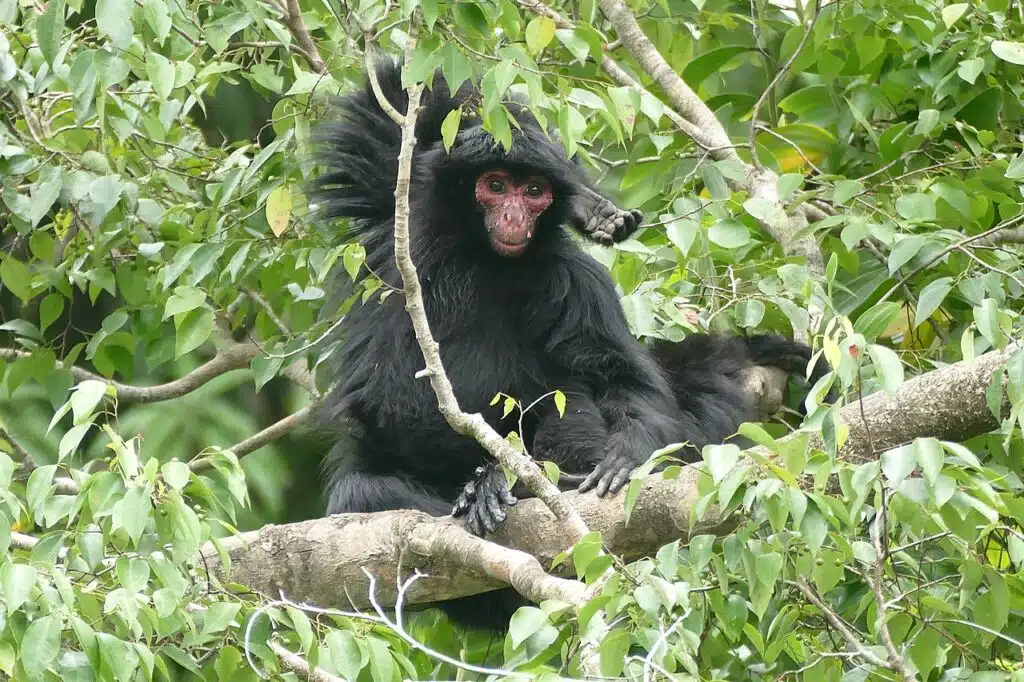
The rainforests of Southern Brazil are home to The Red-Faced Spider Monkey (Ateles paniscus).
Its ability to climb and use its tail to move across the canopy inspires its name, together with its pink-red face.
The face of these monkeys is fully red at birth and slightly brightens as they age. Mostly hairless, the face still shows a few short hairs while the rest of the body has long black hairs.
Males and females share an almost similar size, growing just over 20 inches.
Mostly diurnal, the monkey is highly active when it comes to looking for food, often venturing out on its own before returning to its group.
Each group of these monkeys is formed mostly by females with a few males.
An agile climber and arboreal species, this primate is a species of The Guianas, Brazil, and Suriname. Its rainforest habitat expands through multiple states in the Northern parts of South America.
Living in dense forests, these monkeys are only potentially reached by a few predators, mostly birds, in the areas they live in since they can feed and sleep high up on trees.
2. Bald Uakari
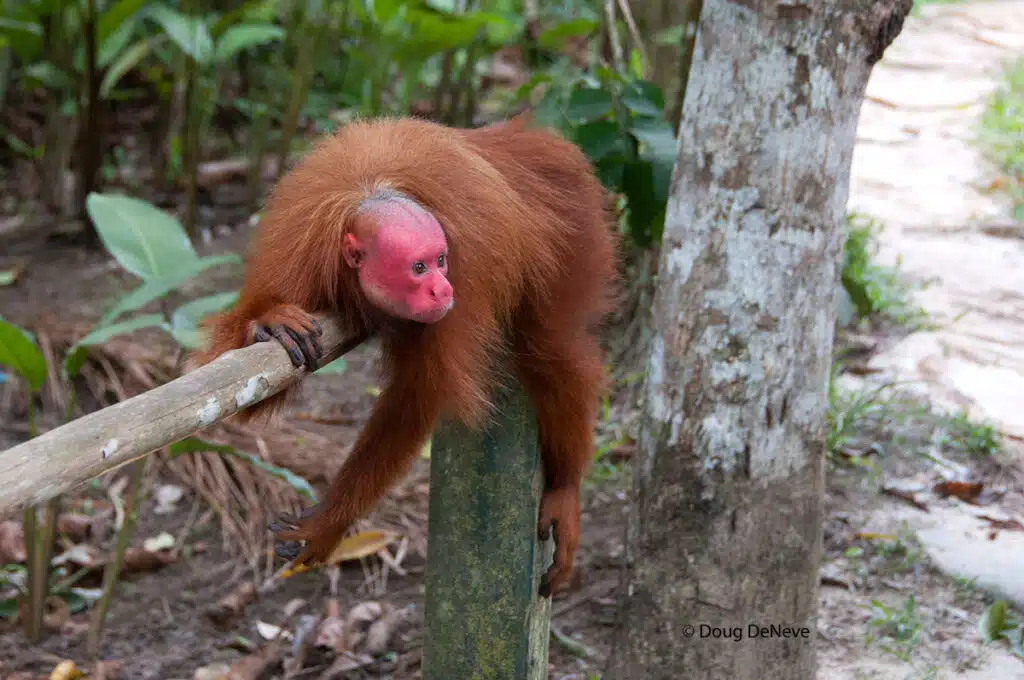
Living in the deep Amazon, Bald Uakaris (Cacajao calvus) are among the most prevalent red-faced monkeys in the world.
These monkeys have red faces and matching bald red heads.
Crimson red is specific to the healthy monkey.
Paler red nuances are signs of sickness and one of the reasons males or females might be avoided by the opposite sex as they might be sick when choosing a prospective mate.
These types of rare and mostly brown monkeys are found in swamps and floodable areas of the rainforest.
This means there are periods when they cannot come down from trees at all. Still, this doesn’t stop them from moving miles per day in the dense forest canopy.
In the dry season, these monkeys come down to look for other types of food and possibly seeds.
A species that can live almost 30 years, these types of monkeys live in small or large groups with both males and females.
Females can attract more males into a group by releasing pheromones.
3. Rhesus Macaque
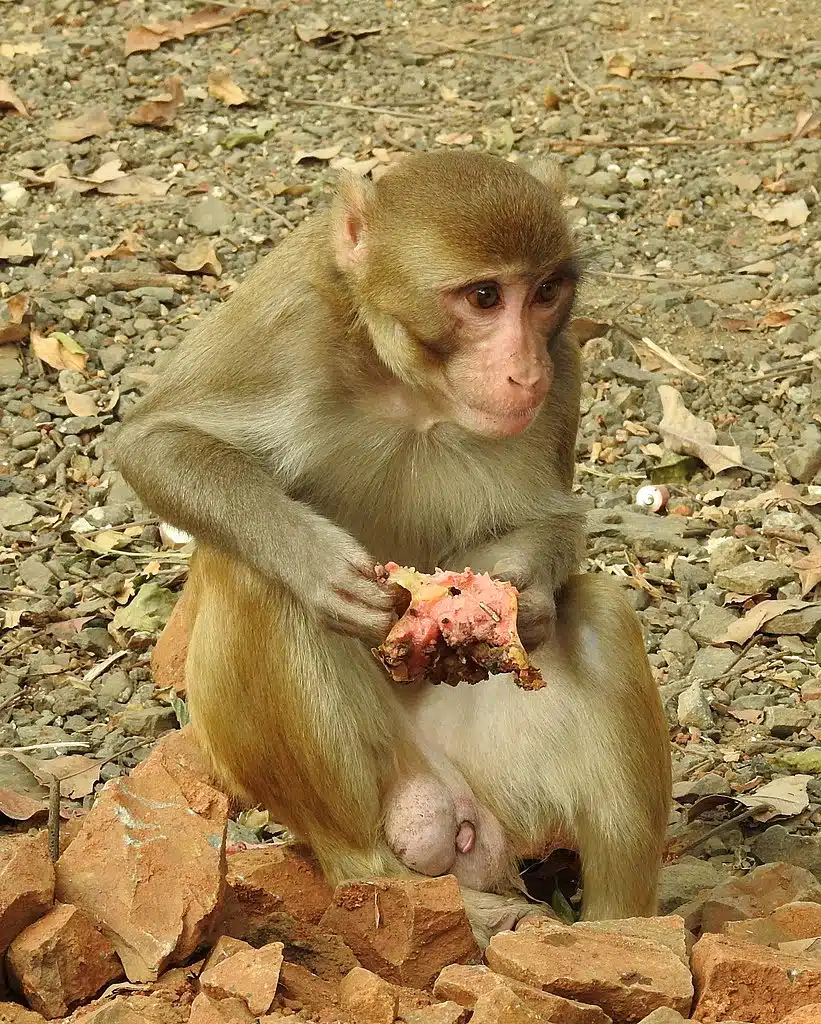
As one of the most widespread monkeys, Rhesus Macaques (Macaca mulatta) are monkeys found in an area spreading from Afghanistan to Pakistan.
These monkeys have pale red faces or pink faces while brown or gray colors dominate their hair.
Macaques of this species can move on 2 feet when on the ground, mostly on toes.
Their habitat expands from forests that are partly evergreen to inhabited areas. Most Rhesus Macaques live in populated areas.
Their adaptations to inhabited areas vary but they can even come close to humans to ask for food.
Most of their lives are spent as herbivores, eating different leaves, plants, and flowers. On occasion, they can eat small insects such as ants.
These monkeys live in very large groups, often numbering hundreds of individuals.
A tendency to have more females in a group is specific to them.
Within the group, there’s a social hierarchy that is typically based on age. The eldest males and females tend to assert dominance over younger group members.
4. Japanese Macaque
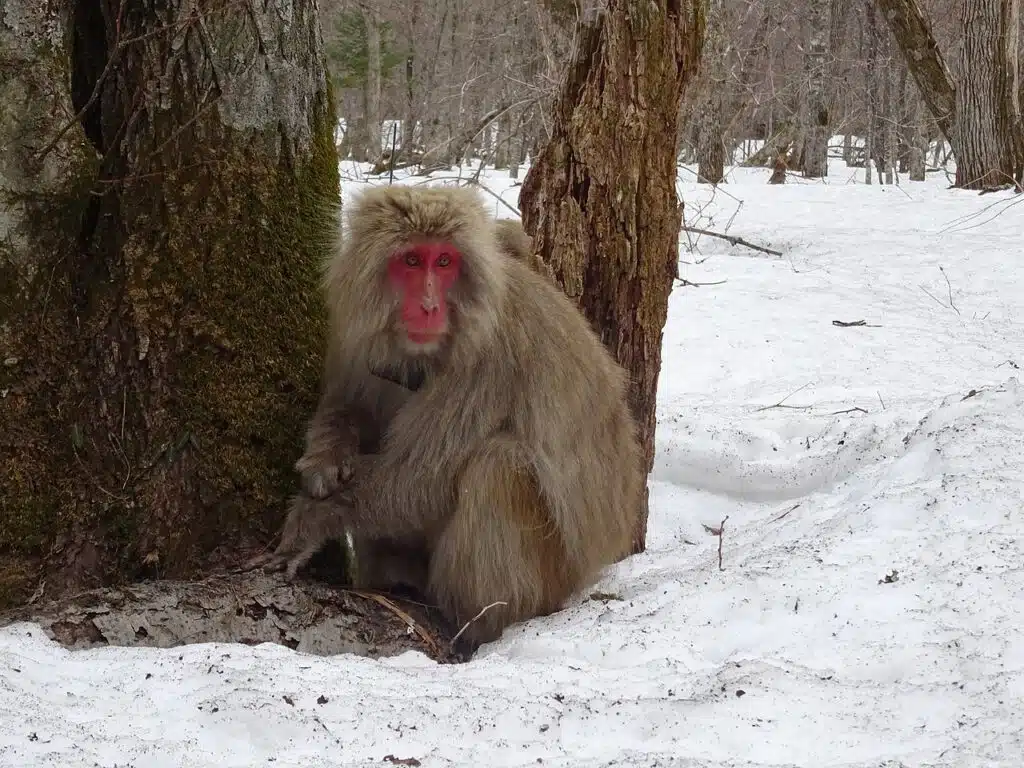
The Japanese Macaque (Macaca fuscata) is the Northernmost monkey with a red face.
The nuance of their faces is bright, in general. Males have bright red faces when entering the breeding season.
Breeding begins when males start to signal females their willingness to breed, often moving backward.
These types of red-faced macaques are believed to be highly intelligent and good copycats.
A diverse diet is specific to this species, together with intelligent feeding traits such as washing their food.
In common culture, Japanese Macaques are associated with the hot springs of Japan, one of the relaxation habits of the species to deal with the cold weather in this region of the world.
These macaques are an important cultural heritage species in Japanese and Chinese cultures alike.
A loss of forested habitat and the introduction of large-scale agriculture also means these monkeys can live in inhabited areas.
They can live in villages as well as around cities. Interestingly, these monkeys have even developed different accents depending on the region of Japan they live in, similar to humans.
5. Stump-Tailed Macaque
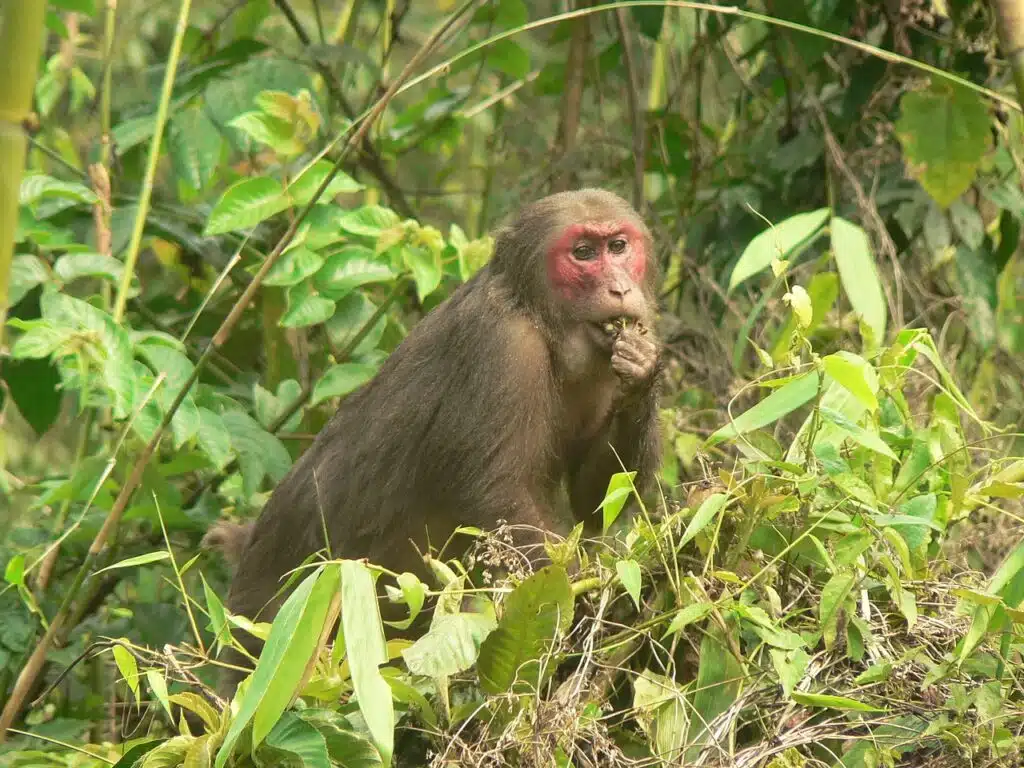
Stump-Tailed Macaques (Macaca arctoides) are among the macaques with red faces in Asia.
This is a species found in Southeast Asia with rivers in Eastern parts of India marking its Western limit.
Red faces are highly specific to younger members of the species. The coloration of the hairless red face darkens over time, with age.
This is a process that can take years, but these monkeys can live decades, like other macaques.
Mostly interested in eating fruit, the species has also been known for eating meat.
These types of monkeys live in social groups, under the rule of females.
While not unusual in the world of monkeys, these types of groups are pacified by leader females who are known to control the rare aggression and fights within the group.
Known to have rather peaceful behavior, these types of monkeys are led by leaders born from previous leaders.
Their leadership roles are passed down from one generation to another.
Found in tropical and subtropical forests, Stump-Tailed Macaques vary in their numbers per group, depending on their region.
The resilience of the species is proven as these types of macaques can live in cool climates at high elevations of up to 13,000 feet.
6. Hamadryas Baboon
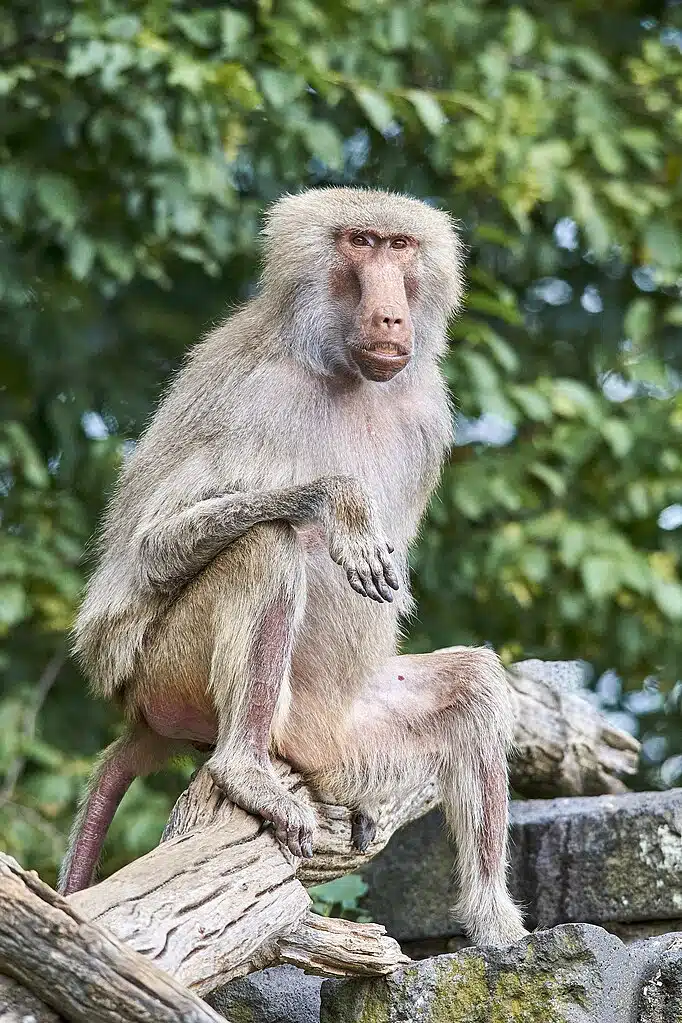
Red faces are common in Hamadryas Baboons (Papio hamadryas), particularly in males. There’s some color variation on the color with red and brown nuances dominating their faces.
Growing up to a size of 30 inches, Hamadryas Baboons have differently-colored males and females.s
They look even longer into their lives. For example, the mantle of males only appears after the age of 10.
These types of baboons are natives of The Somali Peninsula where they live close to water as well as the nearby region of The Arabian Peninsula.
Baboons of the species feed on the lives of local trees and can also feed on a few other fruits in their absence.
Playing an important role in Somali and Egyptian culture and history, this is a species with a long history in East Africa.
Today, the species still lives in the wilderness, mostly organized in small groups, close to water.
This is a species that lives in female-dominated groups with a single male that breeds with all females.
All infants are cared for by mothers or the other females of the group.
7. Golden-White Bare-Ear Marmoset
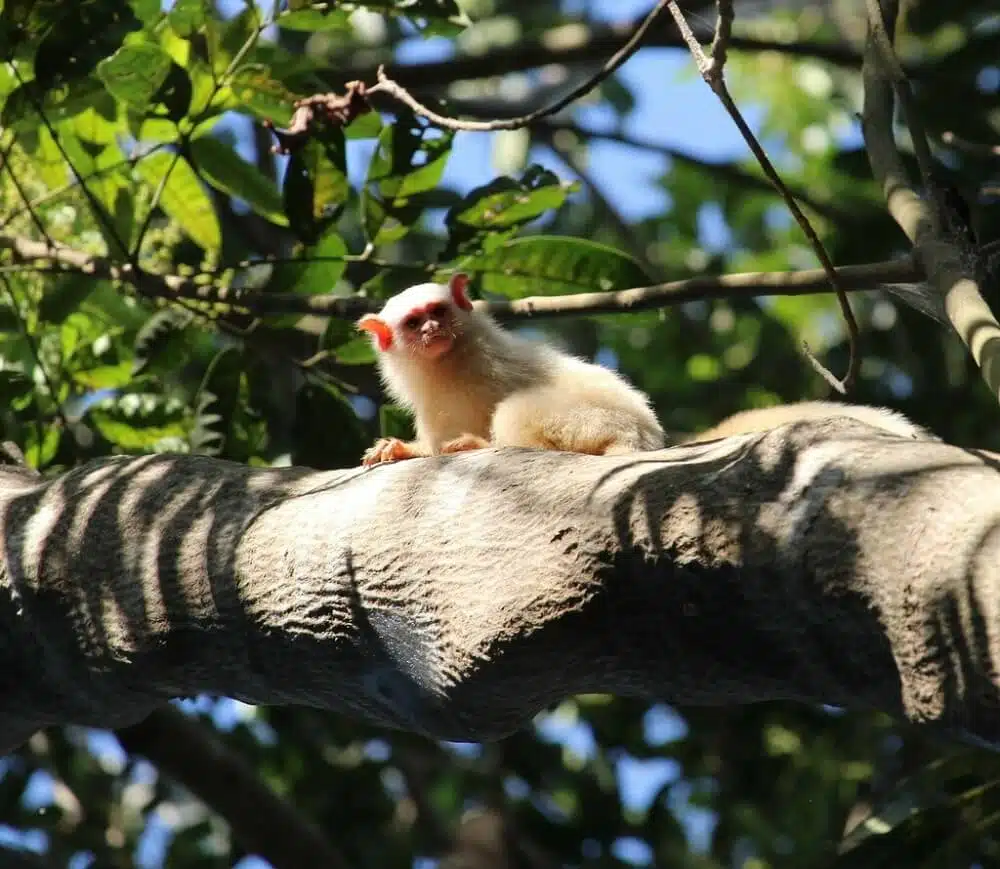
One of the smaller species of monkeys, The Golden-White Bare-Ear Marmosets (Mico leucippe) only grows to 9 inches.
They show bald faces and ears of a bright red nuance and golden-white hairs across their body. They additionally have the same almost white tail color.
Sometimes as small as 6 inches, these types of monkeys live deep in The Amazon Rainforest. Endemic to Paro state in Brazil, they show diurnal activities and an arboreal nature.
These monkeys can eat almost anything they can find, including fruits, leaves, and seeds. They become highly aggressive when it comes to defending their feeding territories.
One way these monkeys stand out in terms of diet is with their capacity to eat sap and resin. They can even use their teeth to bite off tree bark to reach nutrient-rich sap.
Monkeys of this type live together in small groups, of up to 20-30 individuals.
Each group is dominated by a breeding pair. A dominant male breeds with a dominant female and in many cases, these are the eldest and strongest males and females of the group.
High aggression is also specific towards other groups. Dominant males of a group can be among the first to become aggressive in the presence of other groups of this species.
Smaller and more vulnerable to predators than other monkeys, Golden-White Bare-Ear Marmosets live up to 16 years.
8. Formosan Rock Macaque
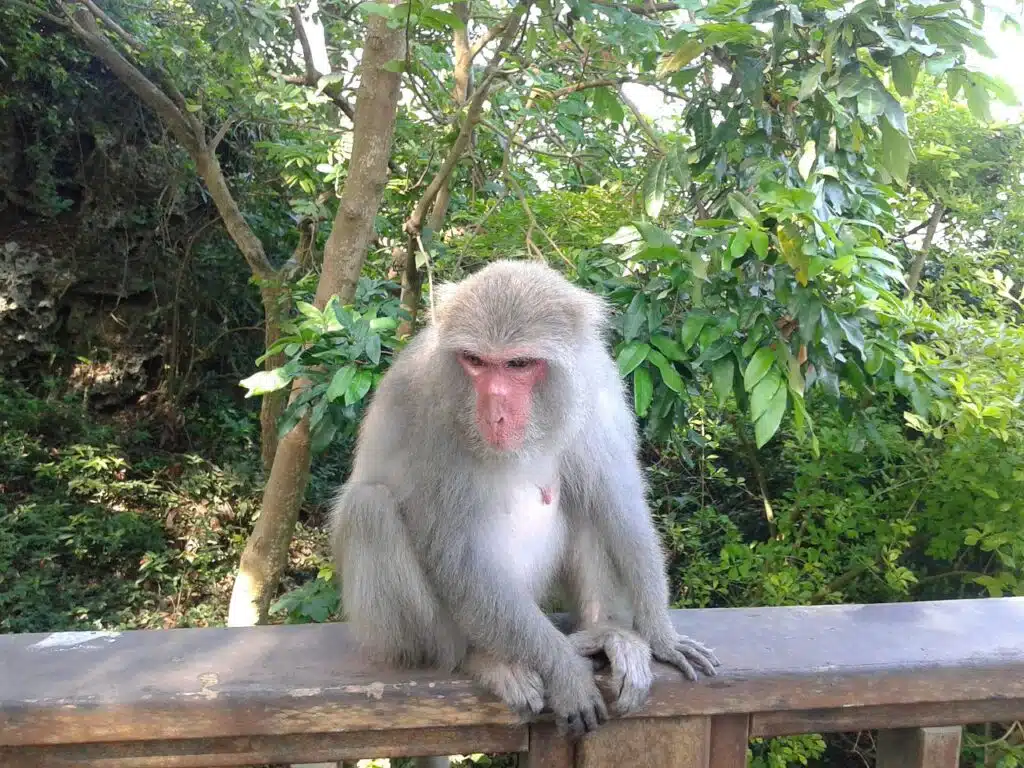
This type of gray macaque (Macaca cyclopis) has a red face throughout its life. From an early age, this is a species that shows red faces and red ears.
The adult also has red faces or pale red faces, depending on their health. The face is typically hairless and surrounded by white hairs while the rest of the body is gray.
Formosan Rock Macaque are among the few primates native to the island of Taiwan. This is a species that spends almost all of its life on trees.
Apart from forests, it can also live among shrubs and in grassland, as long as there’s water and sufficient food.
New leaves and shoots remain their favorites as this species is among the dominant macaques feeding on leaves.
In addition, it can also eat bird eggs it finds in canopy nests.
These types of macaques also live in groups and breed at the end of the year, into January.
Females of the group may or may not work together to raise the offspring.
9. Bonnet Macaque
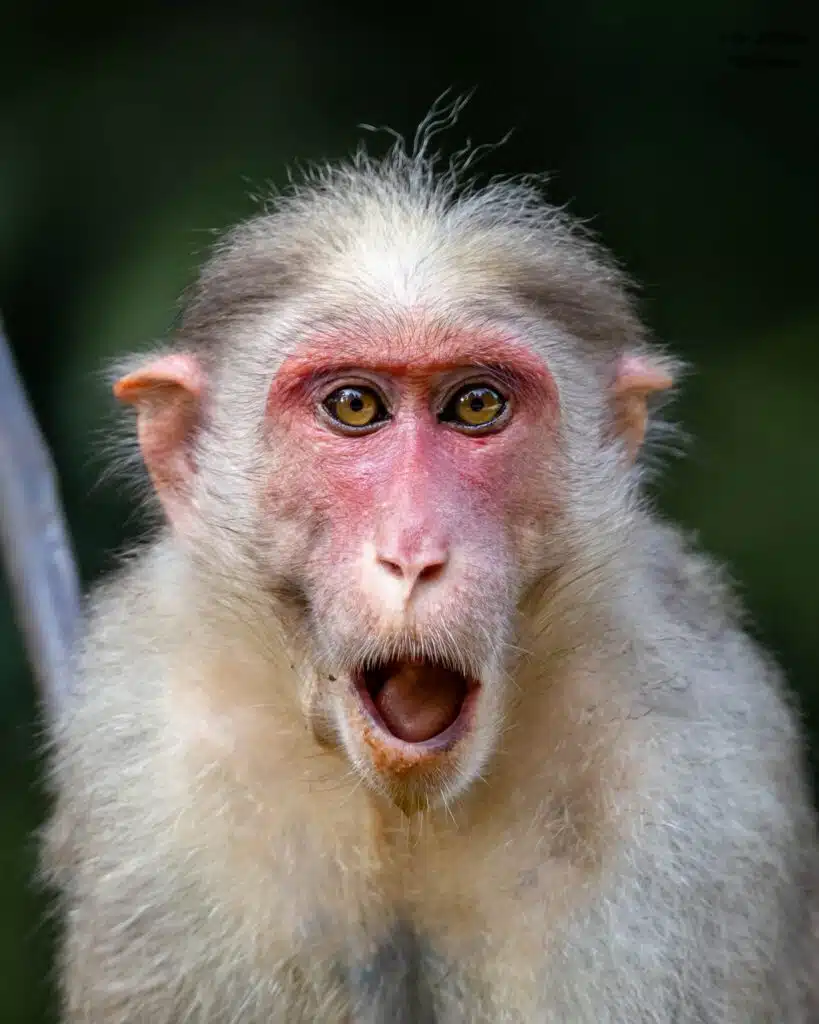
Bonnet Macaques (Macaca radiata) have pink or red faces and are natives to The Indian Subcontinent.
Their hairless faces are seen from their early juvenile days to their old days as they grow. A maximum size of up to 27 inches has been recorded for Bonnet Macaques.
A species that feeds on fruit and seeds, Bonnet Macaques lives in groups.
These are generally peaceful groups compared to other species but in-group aggression can happen when males challenge the role of other males.
Red-faced monkeys of this genus live under a clear male and female hierarchy. There are at least 3 dominant males and one alpha male that lead the group.
Dominant females also exist in the group, but they don’t fight and tend to stay within the group.
Male Bonnet Macaques can fight higher hierarchy males to win their role in the group or they may leave the group and join another group within their life.
While they can fight, Bonnet Macaques rarely do so and tend to help each other out. Their communication tools include loud vocalizations as well as several grimaces.
10. Proboscis Monkey
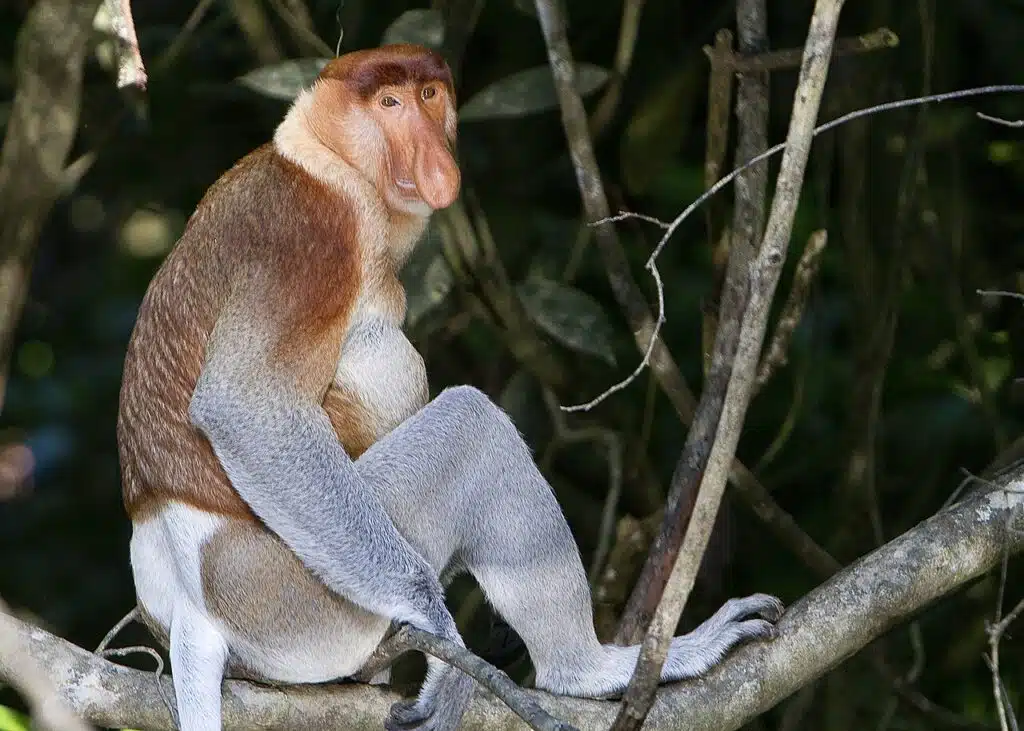
Mostly known for its elongated nose, the Proboscis Monkey (Nasalis larvatus) is among the typical species with a pink-red face or red-brown face that has a multicolored appearance.
Brown, gray, and golden-yellow nuances are specific to its hairs.
Native to Borneo and Malaysia, Proboscis Monkeys have red genitalia once they are ready to breed.
These types of monkeys live in small groups dominated by a single male and formed from female members.
Males that can’t find a group typically live among them until they challenge the role of an alpha male within a group.
A large species that grows to 30 inches, Proboscis Monkeys feed on fruits and leaves.
Multiple species of leaves are eaten by this monkey in different forests. They live in lowland rainforests, swamps, and high tropical forests, but always close to water.
Proboscis Monkeys never leave water proximity and they’re also known to be very good swimmers.
A species of coastal areas, these monkeys generally live in protected areas.